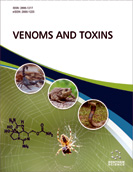Abstract
Introduction: Approximately 90% of reported and identified cases of snakebites in Brazil are caused by species belonging to the Bothrops genus. These snakes have clinical relevance due to their venom composition, which contains substances capable of triggering local and systemic effects, leading to morbidities and/or mortality.
Objective: The objective of this study was to evaluate the toxic and toxinological effects of Bothrops Jararacussu snake venom on zebrafish embryos and larvae.
Methods: The stability of B. Jararacussu snake venom under the conditions used in the toxicity experiments in zebrafish embryos and larvae was evaluated on citrated human plasma. Zebrafish embryos and/or larvae mortality, morphological alterations, spontaneous tail movements and heartbeat caused by the venom were quantified within 96 hours. Toxicity parameters and activity of enzyme-related toxicity biomarkers were evaluated in zebrafish after 96 hours of semi-static exposure to the venom.
Results: The results indicated that the venom causes toxicity in zebrafish embryos and larvae, inducing embryonic mortality, alteration in the number of spontaneous tail movements and activity of biomarker enzymes. The results suggested that the toxic effects caused by the venom in the early stages of zebrafish development are mediated, in part, by neurotoxic action, induction of oxidative and metabolic stress caused by low molecular weight components, and proteins present in this venom.
Conclusion: Toxinological evaluations using the zebrafish as a model are scarce; however, this study presented promising results that encourage the development of future research in toxinology using this animal as a model organism.
Keywords: Bothrops genus; toxinological evaluations, neurotoxicity, oxidative stress, embryo mortality, venom.
[http://dx.doi.org/10.2174/2666121701999200618102634]
[http://dx.doi.org/10.1590/0037-8682-0305-2019] [PMID: 31859953]
[http://dx.doi.org/10.7554/eLife.54076] [PMID: 32633232]
[http://dx.doi.org/10.1038/nrdp.2017.79]
[http://dx.doi.org/10.1016/j.tips.2020.05.006] [PMID: 32564899]
[http://dx.doi.org/10.3390/toxins11010022] [PMID: 30621001]
[http://dx.doi.org/10.3390/ijms22179643] [PMID: 34502548]
[http://dx.doi.org/10.1590/S0036-46652013000500001] [PMID: 24037282]
[http://dx.doi.org/10.35621/23587490.v8.n1.p226-238]
[http://dx.doi.org/10.1016/j.toxicon.2019.09.019] [PMID: 31563525]
[http://dx.doi.org/10.1590/1678-9199-jvatitd-2020-0066] [PMID: 33488681]
[http://dx.doi.org/10.1016/j.peptides.2007.10.010] [PMID: 18006118]
[http://dx.doi.org/10.1016/j.ijbiomac.2020.11.146] [PMID: 33242552]
[http://dx.doi.org/10.1002/JLB.MA1118-463R] [PMID: 31087703]
[http://dx.doi.org/10.1016/j.biochi.2004.02.002] [PMID: 15134836]
[http://dx.doi.org/10.1016/j.toxicon.2009.12.018] [PMID: 20060013]
[http://dx.doi.org/10.1016/j.jprot.2014.11.011] [PMID: 25462430]
[http://dx.doi.org/10.15517/rbt.v65i1.18908] [PMID: 29466649]
[http://dx.doi.org/10.3390/toxins11100564] [PMID: 31557973]
[http://dx.doi.org/10.3390/toxins11050303] [PMID: 31137917]
[http://dx.doi.org/10.1038/s41401-020-00501-7] [PMID: 32843715]
[http://dx.doi.org/10.1590/0001-3765201720170238] [PMID: 28876358]
[http://dx.doi.org/10.1590/1806-9282.63.11.923] [PMID: 29451652]
[http://dx.doi.org/10.1038/nrd1606] [PMID: 15688071]
[http://dx.doi.org/10.1186/s42826-020-00042-4] [PMID: 32382525]
[http://dx.doi.org/10.1371/journal.pone.0021076] [PMID: 21738604]
[http://dx.doi.org/10.1021/acs.chemrestox.9b00335] [PMID: 31625720]
[http://dx.doi.org/10.1038/s12276-021-00571-5] [PMID: 33649498]
[http://dx.doi.org/10.1016/j.reprotox.2014.09.005] [PMID: 25261610]
[http://dx.doi.org/10.1016/B978-0-323-98367-9.00011-1]
[http://dx.doi.org/10.3390/ijms222413417] [PMID: 34948215]
[http://dx.doi.org/10.1038/nrg2091] [PMID: 17440532]
[http://dx.doi.org/10.1038/nature12111] [PMID: 23594743]
[http://dx.doi.org/10.1002/tox.22921] [PMID: 32170993]
[http://dx.doi.org/10.3389/fpsyt.2020.00703] [PMID: 33101067]
[http://dx.doi.org/10.1016/j.ijbiomac.2019.03.059] [PMID: 30867125]
[http://dx.doi.org/10.1016/j.envpol.2021.117096] [PMID: 33866217]
[http://dx.doi.org/10.1016/0003-2697(76)90527-3] [PMID: 942051]
[http://dx.doi.org/10.1016/0006-2952(61)90145-9] [PMID: 13726518]
[http://dx.doi.org/10.1007/978-1-4939-7883-0_26] [PMID: 29896710]
[http://dx.doi.org/10.1371/journal.pntd.0009044] [PMID: 33513145]
[http://dx.doi.org/10.1590/0037-8682-0374-2020] [PMID: 33656146]
[http://dx.doi.org/10.32749/nucleodoconhecimento.com.br/biologia/interesse-em-saude]
[http://dx.doi.org/10.5123/S2176-62232018000300007]
[http://dx.doi.org/10.3390/toxins10100411] [PMID: 30314373]
[PMID: 11910188]
[http://dx.doi.org/10.3390/toxins8100284] [PMID: 27690102]
[http://dx.doi.org/10.1155/2013/153045] [PMID: 24171158]
[http://dx.doi.org/10.1038/s41598-019-47815-z] [PMID: 31383913]
[http://dx.doi.org/10.1007/s10967-016-4770-0]
[http://dx.doi.org/10.1016/S0041-0101(02)00140-X] [PMID: 12220716]
[http://dx.doi.org/10.1016/j.toxicon.2004.06.002] [PMID: 15246772]
[http://dx.doi.org/10.1016/j.biochi.2007.10.005] [PMID: 17996740]
[http://dx.doi.org/10.14573/altex.1804162] [PMID: 30415271]
[http://dx.doi.org/10.3390/ijms21082864] [PMID: 32325940]
[http://dx.doi.org/10.1590/1678-9199-jvatitd-2020-0171] [PMID: 34194483]
[http://dx.doi.org/10.1007/s00726-021-03055-y] [PMID: 34482475]
[http://dx.doi.org/10.2174/1568026615666150217113835] [PMID: 25686732]
[http://dx.doi.org/10.1186/s40409-017-0134-7] [PMID: 29090005]
[http://dx.doi.org/10.1016/j.peptides.2018.01.015] [PMID: 29410030]
[http://dx.doi.org/10.1186/s12302-018-0173-x] [PMID: 30595996]
[http://dx.doi.org/10.1016/j.ecoenv.2019.109754] [PMID: 31606639]
[http://dx.doi.org/10.1089/zeb.2018.1688] [PMID: 30615594]
[http://dx.doi.org/10.1007/978-1-4939-9228-7_9]
[http://dx.doi.org/10.1523/JNEUROSCI.1225-14.2014] [PMID: 25031404]
[http://dx.doi.org/10.3389/fnmol.2016.00050] [PMID: 27445686]
[http://dx.doi.org/10.3390/w13020119]
[http://dx.doi.org/10.3390/toxins10110474] [PMID: 30441876]
[http://dx.doi.org/10.1038/s41598-020-58563-w] [PMID: 32029752]
[http://dx.doi.org/10.1016/j.toxicon.2007.07.002] [PMID: 18023464]
[http://dx.doi.org/10.1016/j.toxicon.2012.04.216] [PMID: 22178782]
[http://dx.doi.org/10.1080/10717544.2021.2012307] [PMID: 34894947]
[http://dx.doi.org/10.1007/s40071-016-0147-9]
[http://dx.doi.org/10.1111/nyas.13051] [PMID: 27123828]
[http://dx.doi.org/10.1016/j.chemosphere.2016.11.004] [PMID: 27836271]
[http://dx.doi.org/10.1016/j.envpol.2020.114775] [PMID: 32504889]
[http://dx.doi.org/10.3390/antiox10050701] [PMID: 33946704]
[http://dx.doi.org/10.2147/OTT.S115055] [PMID: 27799796]
[http://dx.doi.org/10.1016/j.electacta.2005.08.038]
[http://dx.doi.org/10.1016/j.ijbiomac.2019.01.059] [PMID: 30654040]
[http://dx.doi.org/10.3390/molecules26227057] [PMID: 34834153]
[http://dx.doi.org/10.1155/2020/5346483] [PMID: 32607139]
[http://dx.doi.org/10.1038/s41598-020-73042-y] [PMID: 33057045]
[http://dx.doi.org/10.1016/j.scitotenv.2016.11.153] [PMID: 28209406]
[http://dx.doi.org/10.1016/j.redox.2019.101339] [PMID: 31610469]
[http://dx.doi.org/10.1002/cac2.12080] [PMID: 32820611]
[http://dx.doi.org/10.1371/journal.pone.0152890] [PMID: 27058357]
[http://dx.doi.org/10.1016/S0076-6879(84)05016-3] [PMID: 6727660]
[http://dx.doi.org/10.1038/s41598-018-37435-4] [PMID: 30692577]
[http://dx.doi.org/10.1590/1678-9199-jvatitd-2020-0123] [PMID: 33354202]
[http://dx.doi.org/10.1016/j.jab.2014.11.002]
[http://dx.doi.org/10.1590/s0100-83582017350100044]
[http://dx.doi.org/10.1042/BST20200110] [PMID: 32267491]
[http://dx.doi.org/10.3389/fimmu.2019.02082] [PMID: 31572356]
[http://dx.doi.org/10.3390/toxins13120868] [PMID: 34941706]
[http://dx.doi.org/10.1016/j.ijbiomac.2017.05.025] [PMID: 28495622]
 15
15 2
2




